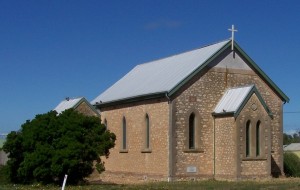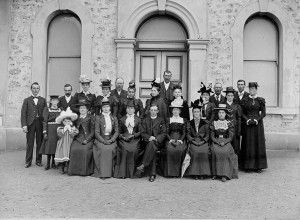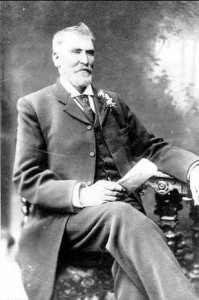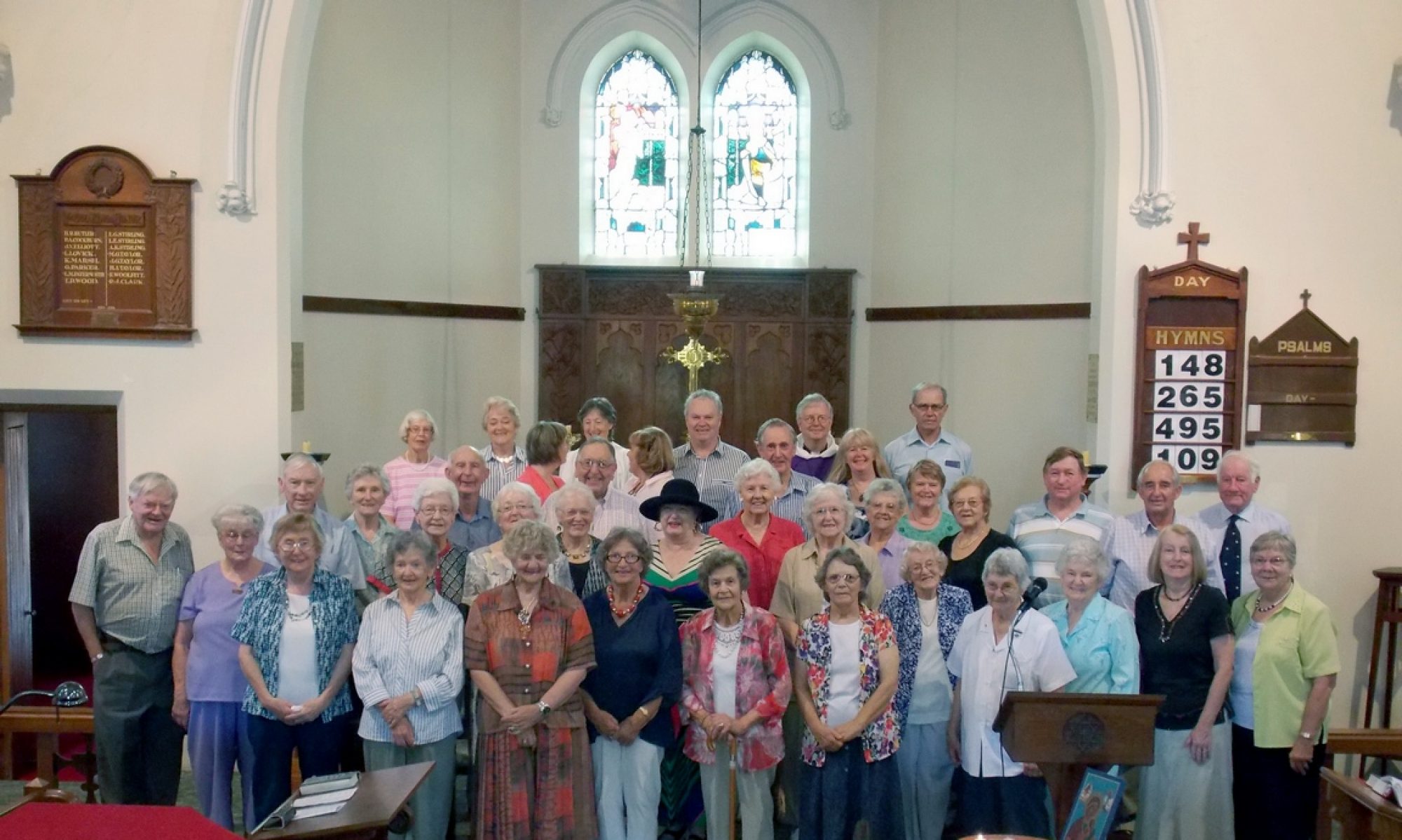
Beginnings
According to Alexandrina’s Shore (page 117) the first Church of England service was held in 1861 by the Reverend John Fulford. He could very well have conducted the first service as, starting in April 1851 he was the priest with the responsibility for Blakiston with Kanmantoo, Big Waterhole Creek, Braemer, Port Elliot, Goolwa, Currency Creek, Macclesfield and Strathalbyn. However he left in 1858 and for the next two years visited England before coming back to Kooringa and Redruth with the East Narrien Mission.
On the other hand, the newspaper report of the dedication of St Mary’s credited the Reverend Henry Bevis with conducting the first services ‘in a wheat store lent by the late Mr A. H. Landseer about 31 years ago. Then the Oddfellows’ Hall was used, and afterwards the Institute Hall…’ Henry Bevis was Missionary Chaplain of Strathalbyn, Echunga, Meadows and Langhorne’s Bridge from July 1877 and then Incumbent from January 1878 until he resigned from the parish and returned to England in 1879.

In Milang regular services were held in the Institute after it was opened on New Year’s Day 1884 by the Hon. James Rankine, M.L.C.. In 1897 services were held every three weeks. In 1900 an organ was purchased to accompany the singing and there was a regular Sunday School class, taught by Mrs Ernest Dunk. However, plans were being made for a building of their own. ‘In latter years the members have held a strawberry fete annually, and the proceeds have been set aside with the idea of building a church. Towards the end of last year (i.e. 1910) it was thought that, with the money in hand and some subscriptions collected by Mr. W. P. Dunk, who gave the ground, it was an opportune time to have designs for a church prepared. This was done, and, with slight alterations, the work was put in hand.’
Foundation Stone

On Monday 27th February 1911 the foundation stone of St Mary’s was laid by Mrs W. P. Dunk in the presence of a large gathering. The preacher for the occasion was the Reverend E. H. Bleby, the Rector of St Paul’s, Adelaide and a former Priest-in-charge of the Milang Mission.
The church was built by Mr R. Oldfield under the supervision of Mr Dunk and was completed towards the end of June. It was constructed of ‘limestone, with cement dressings and leadlight windows. It measures 40 ft by 25 ft, inside.’
On the afternoon of Friday 25th August 1911 the building was dedicated by the Bishop of Adelaide, the Right Reverend Arthur Nutter Thomas, as the Church of Saint Mary the Virgin, in the presence of a large congregation which ‘taxed to the utmost’ the accommodation of the building. The petition was read by the Reverend T. Percy Wood [the Rector of the Parish], the Deed of Dedication by Sir J. Lancelot Stirling, while the Bishop gave the address. The music was led by an augmented choir with Miss Tripp at the organ.
‘The Bishop spoke of the difference they would notice between a building ever open for prayer and meditation and the problems associated with worship in a secular building.’
According to The Southern Argus as a result of ‘exceptionally favourable weather conditions’ a large crowd gathered ‘at the Lakeside township, all the surrounding districts contributing to the crowd.’
‘Langhorne Creek, Lake Plains, Angas Plains, Pt Sturt and Finniss – all were represented as well as a crowd from Milang and Strathalbyn – the latter contingent included the Mayor and Mayoress (Mr and Mrs C.L.A. Wyatt), Sir Lancelot and Lady Stirling, Dr and Mrs H.H. Formby, Mr and Mrs E. J. Tucker, J. W. Elliott, P.A. Cockburn, S.W. Rogers and many others.
At the conclusion of the Vestry Meeting in 1912 the members held a business meeting at which the Secretary stated that beside the £200 which they had borrowed from the Church Office they also owed Mr W.P. Dunk the sum of £124-13-0. Mr Dunk was agreeable to let it remain and to be paid off as funds would allow but the meeting agreed to the Secretary’s proposal that they should pay back the odd money immediately, leaving £100 still to be repaid.
W.P. Dunk

The account of the building of the church makes it clear that the congregation was greatly endebted to Mr W.P. Dunk for his enthusiasm and practical support for the project. The church was named after his childhood parish church, Saint Mary the Virgin, Chatham in Kent, England and his contribution would be acknowledged after his death by the addition of the apse at the east end of the building in his memory.
William Peter Dunk was born in Brompton, Kent and when he was nineteen he married Emma Chalklen from Brompton just before they emigrated to South Australia. They arrived in Semaphore on the Jannet in January 1858 and settled in Milang in 1859.
‘He began work for A.H. Landseer and eventually became a partner in the firm. After many years, the partnership was dissolved and W.P. Dunk began business on his own account as a merchant, ship owner, and mail contractor. In 1920 the business was described in the Southern Argus as “one of the liveliest concerns of the south, including in its operations quite a little fleet of steamers and sailing boats trading on the lakes and lower river.”’ (Alexandrina’s Shore page 89)
At the Vestry meeting in 1915 a letter was received from the Reverend W.J. Bussell, the Organizing Chaplain of the Bishop’s Home Mission Society, that the grant received from the Society would be reduced to £30. In spite of this Mrs E.A. Dunk moved that the Rector’s stipend should be increased by £5 to a total of £50 per annum, including the Christmas gift of £5.
This increase in local support meant that the Rector ‘would now be able to ask that St Mary’s be taken off the list of Mission Churches.’ At about the same time the church became eligible to have its own Synod representative and representatives on the Parish Patronage Committee if they needed to appoint a new Rector.
At the Vestry Meeting in 1917 Mr H. Grierson reported that the sum of £33-6-8 had been paid to Mr Dunk off the Church debt, leaving a balance of the same amount to be paid.
In 1917 W.P. Dunk and his wife, Emma celebrated their sixtieth wedding anniversary, but she died on the 9th November 1917. At the Vestry meeting on Saturday 20th April 1918 the Rector ‘referred to the loss to St Mary’s by the death of Mrs Dunk which was deeply regretted by all.’ He then went on to thank Mr Dunk for his generosity in handing a Receipt for the balance due to him on the Building Account, viz £33-6-8 which had freed the Church from debt. Mr Dunk emphasized that the gift was from the Dunk Family and not just from himself.
Church Consecration
With the Church building free of debt the Rector had contacted the Bishop who ‘had consented to consecrate St Mary’s and would if possible arrange for one Sunday in June or July.’
As promised, the Bishop of Adelaide, the Right Reverend Arthur Nutter Thomas, performed the ceremony of Consecration on Sunday 21st July 1918 which was described in detail in the Southern Argus on the following Thursday:
‘The ceremony of consecrating the edifice was conducted with due solemnity in the presence of a large and very representative congregation, the Church having all its seating accommodation taxed to the utmost extent.
“An augmented choir, with Miss Tripp (who has been organist since the mission opened) at the organ, the musical portion of the service being performed in admirable manner, adding very considerably to the success of the proceedings, and reflecting credit on choir and organist.
‘The Rev. T.P. Wood read the petition for consecration, and after the Bishop had performed the various rites, the deed of the diocese was read by Sir J. L. Stirling, representing synod and the patronage committee.
‘The Bishop then addressed the congregation on the subject of the sacredness of the Church, and its claims for their regard not only as a place for Sunday worship but as a home, a place to which to take their troubles, their sorrows, their cares, to consecrate their joys, to bless their relationships the one with the other, to mark all the important steps in their life’s journey from the cradle to the grave.
‘The sermon was a very impressive one, one finding an echo in the hearts of all present, appealing as it did so effectively to the human feelings of those who were privileged to hear it.
“At the close of the service, the whole of the congregation were invited by Mr W.P. Dunk and his family, with customary boundless hospitality, to partake of afternoon tea, a lavish spread being set out at his residence for his many guests.
“During the afternoon Mr Dunk had many appreciative compliments paid to him on his attainment to his eightieth year, as well on his useful work for the Church and the whole district.’
One other comment in that newspaper report indicated that the members of the congregation felt that their task was not yet completed. ‘No sooner was the debt on the Church building paid than these devoted church-workers began to raise money to build on an apse, which will complete the design of the Church. Already a substantial sum has been got together and it is hoped to begin this work before long.’ Unfortunately it would be another ten years before their hopes were realized.
Conclusion
The apse was completed in 1928 as a memorial to Mr W.P. Dunk at a cost of £160-0-0, and was dedicated on Sunday 17th June 1928 by Archdeacon Bussell, acting in behalf of the Bishop of Adelaide. At the same time two stained glass windows in memory of Mr. and Mrs. Dunk, were unveiled, and a reredos in memory of Mr and Mrs Tinks, a credence table, presented by Mrs. Grierson and Mr. H. Grierson, in memory of Magnus Grierson, and a hymn board in memory of W.E. Titterton were dedicated.
